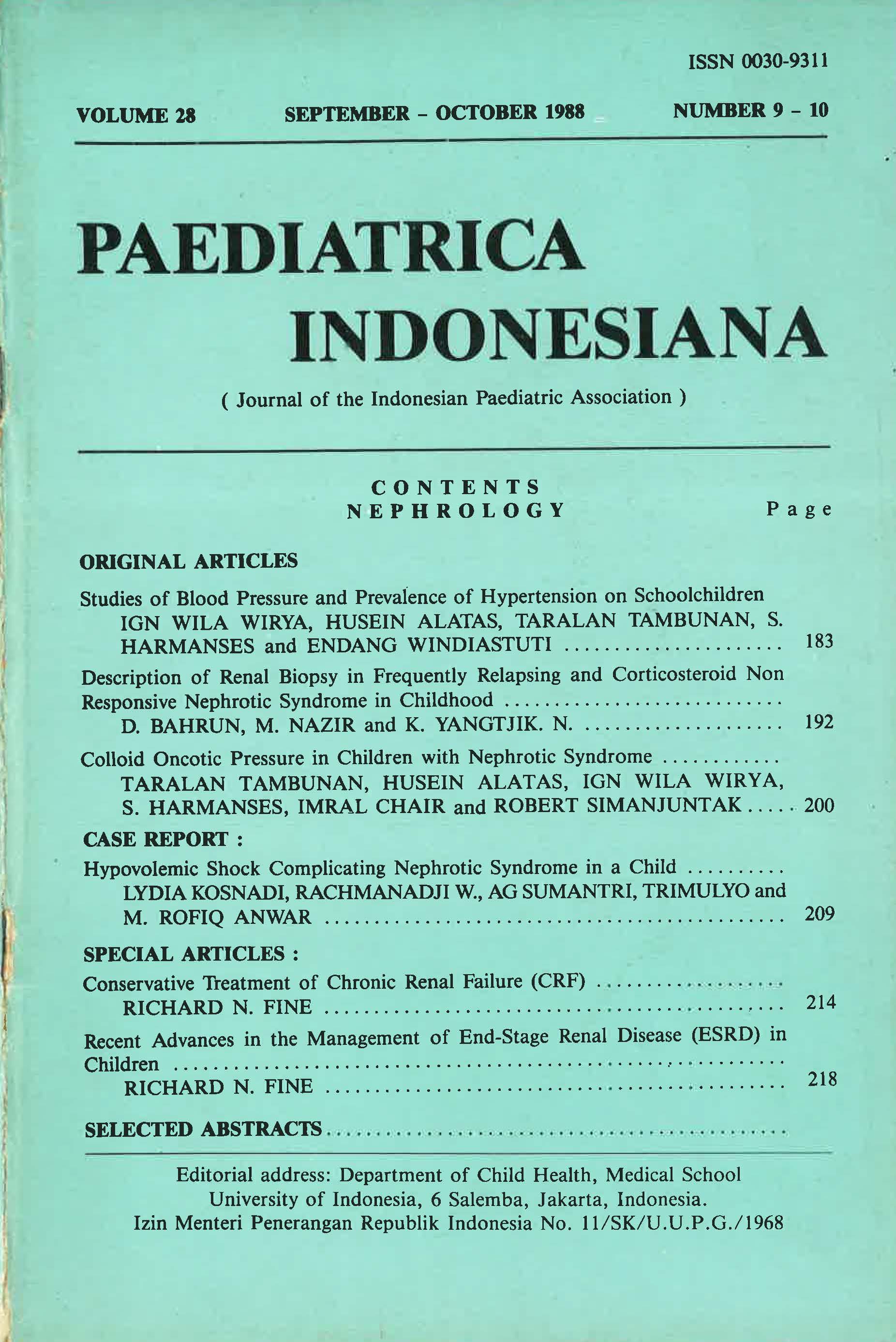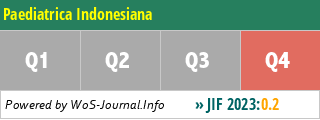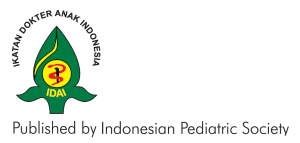Colloid Oncotic Pressure in Children with Nephrotic Syndrome
DOI:
https://doi.org/10.14238/pi28.9-10.1988.200-8Keywords:
colloid oncotic pressure; nephrotic syndrome; COP; plasma protein concentrationAbstract
To evaluate the correlation between plasma protein concentration and colloid oncotic pressure (COP) and their influence on clinical symptom of edema, we studied 30 children with nephrotic syndrome (NS). Total plasma protein concentration (TP), albumm, globulin and COP were measured in all patients in edema forming state (EF) and m steady state phase (SS), except for COP, only 16 samples in SS phase.
COP TP plasma albumin and globulin contents in EF group were 8. 7 ± 2. 7 mmHg, 4.07 '± 0.68 g/dl; 2.57 ± 0.50 g/dl and 1.51 ± 0.32 g/dl, respectively. In SS group these figures rose significantly to 16.7 ± 3.9 mmHg for COP; 5. 70 ± 0.99 g/dl for TP; 3.46 ± 0.52 g!dl and 2.06 ± 0.56 g/dl for plasma albumin and globulin, respectively. We also found the high correlation both between COP and albumin content (r= +0.58; p < 0.01) and between COP and TP (r= +0.54; P < 0.01) .
A strong negative correlation was also found between COP and the degree of edema (r = _ 0.55; p <0.01). On the other hand a very low grade correlation was noticed between plasma albumin content and the degree of edema (r= - 0.26; P < 0.05) and no correlation at all was found between edema and TP (r= - 0.19; P > 0.05).
We conclude that COP has the highest correlation with plasma protein concentration and the degree of edema, and can be used as a diagnostic tool. It is even more sensitive and simple compared with the TP or albumin content determination.
References
2. GANDASOEBRATA, R.: Penuntun Laboratorium Klinik, edisi ll, 16 7- 170 (Dian Rakyat, Jakarta 1970) .
3. HASSAN, R.; CHAIR, l. ; DARWlS. D. ; LATIEF, A.: Colloid oncotic pressure in severe dengue shock syndrome. Pediatr. lndones, 26 : 213-219 (1986).
4. KOOMANS, H.H. ; GEERS, A.B.; DORHOUT, M. E. J.; KORLANDT, W : Lowered tissue-fluid oncotic pressure protects the blood volume in the nephrotic syndrome. Nephron 42 : 317-322 (1986).
5. NODDELAND, H. ; RUSNES. S.; l ADNES. H.O.: Interstitial colloid osmotic pressure in patients with hypoproteinemia . Acta physiol. scand. 108: 6- 13 (1982).
6. Report of the International Study of Kidney Disease in Children (lSKDC): Nephrotic syndrome in children: A randomized trial composing two prednisone regimen in steroid responsive patients who relapse early. J. Pediatr. 955 : 239-243 (1979).
7. Repo rt of lSKDC: Early identification of frequent relapses among children with minimal change nephrotic svndromeJ. Pediat. 101:514-518 (1982).
8. SCHREINER. G. E . : The nephrotic syndrome. Ann. Intern. Med . 64:300-308 (1963).
9. STARLING, E. H. : On obsorbtion of fluid from connective tissue spaces. J. Appt. Physiol. 19: 312-312 (1896); cited from Weil et al., 1978.
10. WEIL, M. H . ; MORISETTE. M.; MlCHAELS. S. : Routine plasma colloid oncotic pressure measurement. Crit Care Med. 2:229 (1974).
11. WEIL, M.H.; HENNlNG, R . J.; MORISETTE, M; MICHAELS. S. : Relationship between colloid osmotic pressure and pulmonarv artery wedge pressure in patients with acute cardiorespiratory failure. Am. J. Med. 64: 643-650 (1978).
12. WEIL, M. H.; HENNING R. J.; PURI, V. K.: Colloid oncotic pressure: clinical significance. Crit. Care Med. 7: 113-116 (1979).
Downloads
Published
How to Cite
Issue
Section
License
Authors who publish with this journal agree to the following terms:
Authors retain copyright and grant the journal right of first publication with the work simultaneously licensed under a Creative Commons Attribution License that allows others to share the work with an acknowledgement of the work's authorship and initial publication in this journal.
Authors are able to enter into separate, additional contractual arrangements for the non-exclusive distribution of the journal's published version of the work (e.g., post it to an institutional repository or publish it in a book), with an acknowledgement of its initial publication in this journal.


















